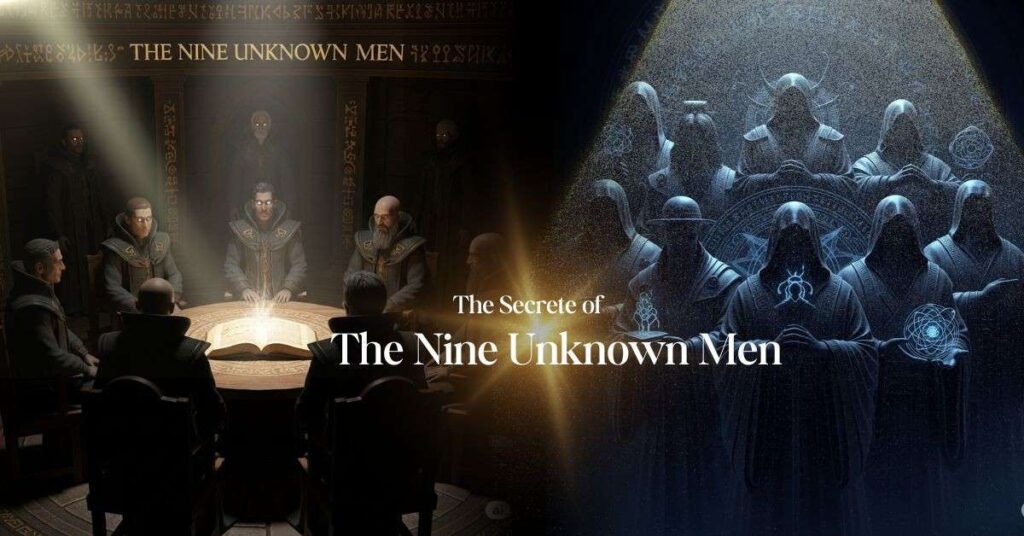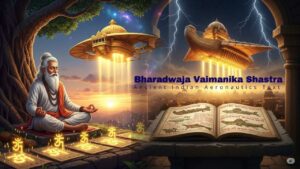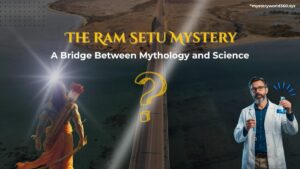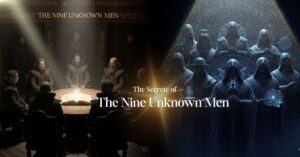The Nine Unknown Men: India’s Mysterious Secret Society
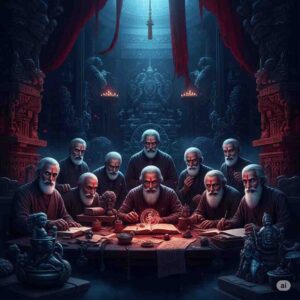
Believed to be an ancient Indian secret society, the Nine Unknown Men have been shrouded in mystery and conspiracy theories for over two millennia. This legendary group is said to have been founded by none other than the great Emperor Ashoka himself, making it deeply intertwined with India’s rich historical and mystical heritage.
Who Are the Nine Unknown Men? | The Nine Unknown Men
Following the devastating Kalinga War, Emperor Ashoka, transformed by remorse, allegedly created this secret society to safeguard and preserve powerful and forbidden knowledge. Each of the nine men was entrusted with guarding a specific book of knowledge containing secrets so dangerous that they could disrupt society if misused.
This incredible collection of knowledge is said to have been passed down through generations, hidden from the public eye, ensuring the survival of India’s most powerful and secret wisdom.
Emperor Ashoka Secret Society: The Origins | The Nine Unknown Men
Ashoka ruled the Mauryan Empire in the 3rd century BCE and was known for his drastic transformation from a ruthless conqueror to a peace-loving Buddhist emperor. After witnessing the horrors of the Kalinga War, Ashoka supposedly wanted to prevent knowledge that could be harmful in the wrong hands from spreading.
Hence, the Emperor Ashoka secret society was born, comprising nine men who were assigned the sacred duty of protecting this knowledge. Each member was said to be an expert in their field, carefully guarding their respective book. The secrecy surrounding this group has led to decades of speculation and myth-making, often compared to other mysterious organizations like the Freemasons or the Illuminati.
The Indian Illuminati Connection
Many conspiracy theorists link the Nine Unknown Men to the concept of the Indian Illuminati. This idea suggests that a powerful, secretive elite has influenced political, spiritual, and scientific realms within India—and possibly globally—through covert means. The Indian Illuminati is believed to be a continuation or evolution of the ancient Nine Unknown Men, wielding hidden power behind the scenes.
The parallels between the Nine Unknown Men and the Illuminati make this theory all the more captivating. Both are described as clandestine groups controlling secret knowledge and manipulating world events from the shadows. While there’s no concrete evidence to confirm these claims, the enduring fascination with the Nine Unknown Men keeps the legend alive in popular culture and conspiracy circles alike.
What Kind of Knowledge Did The Nine Unknown Men Guard?
According to the myths, the Nine Unknown Men each held a book dedicated to a specific area of knowledge:
- Propaganda and Psychological Warfare
- Physiology and Microbiology
- Alchemy and Transmutation of Metals
- Communication and Cosmology
- Gravitation and Cosmic Energy
- Light and Optics
- Sociology and Political Science
- Biology and Genetic Engineering
- Time and Space Manipulation
The idea that such knowledge was possessed and protected by a secret society over thousands of years gives the Nine Unknown Men a near-mythical status. These topics, ranging from spiritual science to cutting-edge technology, fuel the intrigue around what might be hidden from the public eye.
Are The Nine Unknown Men Real?
Skeptics argue that the Nine Unknown Men are purely mythological or symbolic—a metaphor for secret knowledge kept by rulers and sages in ancient India. However, the persistence of stories about the Nine Unknown Men through centuries, along with claims by some historians and writers, suggests there might be a kernel of truth.
Western authors like Talbot Mundy and Louis Pauwels popularized the concept in the 20th century, fueling global curiosity. Some even believe that this secret society influenced modern science and technology, or that it still operates in secret today, protecting humanity from dangerous knowledge.
The Legacy of The Nine Unknown Men Today
In modern times, references to the Emperor Ashoka secret society and the Indian Illuminati reflect ongoing fascination with hidden knowledge and secret power structures.
The Nine Unknown Men symbolize the eternal human quest for knowledge, the tension between power and responsibility, and the idea that some truths are too dangerous for the world to know.
🕉️ 1. The Transformation After Kalinga | The Nine Unknown Men
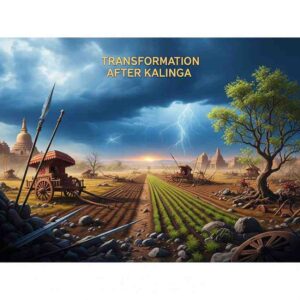
Ashoka started his reign with conquests and warfare. However, after witnessing the horrific bloodshed of the Kalinga War, where over 100,000 people reportedly died, Ashoka underwent a dramatic transformation.This sudden shift has puzzled historians and spiritual thinkers alike—why such a complete change of heart? Was it genuine remorse, or did he learn something secret that shocked him into non-violence?
🕵️ 2. The Creation of The Nine Unknown Men
Legend claims that after the Kalinga War, Ashoka realized the immense danger of unchecked knowledge and power. Some say these areas included:
- Propaganda and mind control
- Biological warfare
- Anti-gravity
- Time travel
- Alchemy
- Telepathy
- Light speed travel
This group was to protect humanity from itself, passing knowledge down secretly through generations, hidden from rulers, scientists, and even religious leaders. Many believe this society still exists today, influencing events from the shadows.
🧬 3. Hidden Knowledge and Advanced Science | The Nine Unknown Men
The mystery of Ashoka deepens with tales of ancient Indian science and technology far ahead of its time—things that might have been in the Nine Unknown Men’s books. Some legends speak of:
- Flying machines (Vimanas)
- Ancient nuclear weapons (as described in the Mahabharata)
- Advanced surgery, robotics, and genetic science
Was Ashoka trying to hide proof of an ancient advanced civilization?
🔒 4. Ashoka’s Edicts: A Coded Warning? | The Nine Unknown Men
Ashoka left behind dozens of stone edicts across India and beyond, inscribed with messages about morality, dharma, and peace. But some theorists believe these were more than just public proclamations—they were coded messages, hiding deeper truths known only to the Nine.
👁️🗨️ 5. Ashoka and the Indian Illuminati | The Nine Unknown Men
Modern conspiracy theories link Ashoka’s secret society with what some call the Indian Illuminati—a hidden network of powerful people guarding spiritual and scientific secrets. Some even claim they influenced major historical events globally and that their knowledge surpasses anything known publicly today.
🪨 What Are the Edicts of Ashoka? | The Nine Unknown Men
These were issued during the reign of Emperor Ashoka (circa 268–232 BCE) to communicate his policies, moral teachings, and administrative decisions to his people.
🏛️ Types of Edicts:
- Major Rock Edicts – 14 large inscriptions carved on natural rock surfaces.
- Minor Rock Edicts – Shorter messages on smaller rock surfaces, often personal or religious in tone.
- Pillar Edicts – Inscribed on massive stone pillars placed across the empire, showcasing Ashoka’s commitment to dharma (righteousness).
- Minor Pillar Edicts – Smaller inscriptions often related to Buddhism or specific orders.
📜 What Did These “Royal Codes” Say? | The Nine Unknown Men
The Ashokan edicts covered themes like:
- Moral and ethical behavior (Dhamma)
- Non-violence and religious tolerance
- Respect for all living beings
- Justice and good governance
- Promotion of Buddhism
These edicts were written in multiple languages and scripts, such as Prakrit in Brahmi script, and were placed strategically where people could see and learn from them.
🧩 Fun Fact: Hidden Messages? | The Nine Unknown Men
Some theorists believe Ashoka’s edicts may have hidden meanings—possibly coded messages linked to the Nine Unknown Men. While historians view them as public moral decrees, conspiracy theorists argue they hint at secret knowledge or warnings embedded in plain sight.
👑 1. Devi (Vedisa Devi)
- Devi was Ashoka’s first wife, whom he married while serving as the governor of Ujjain (before becoming emperor).
- She was the daughter of a merchant from Vidisha (modern-day Madhya Pradesh).
- Devi is considered to be Ashoka’s Buddhist wife and is believed to have had a major influence on his spiritual path.
- She gave birth to Mahendra (Mahinda) and Sanghamitta, who later played key roles in spreading Buddhism to Sri Lanka.
- Interestingly, Devi did not accompany Ashoka to Pataliputra (the capital), and lived separately in Vidisha.
👑 2. Asandhimitra
- Asandhimitra was Ashoka’s chief queen after he became emperor.
- She came from a royal family and held significant status in court.
- Ancient texts describe her as wise, compassionate, and deeply supportive of Ashoka’s rule.
- She is said to have died before Ashoka, and her passing deeply saddened him.
👑 3. Tishyarakshita
- After Asandhimitra’s death, Ashoka married Tishyarakshita.
- She is portrayed in some texts as beautiful but ambitious and manipulative.
- According to legend, she did not get along with Ashoka’s son Kunala, and some stories suggest she tried to blind him out of jealousy or political rivalry.
⚰️ 1. Decline of the Maurya Empire
- Ashoka’s death marked the beginning of the end for the mighty Maurya Empire.
- He was succeeded by Dasharatha Maurya (his grandson), but none of his successors possessed Ashoka’s charisma, vision, or political strength.
- The central authority weakened, and regional governors began asserting independence.
- Within 50 years, the Mauryan Empire collapsed completely. The last Mauryan king, Brihadratha, was assassinated by his general Pushyamitra Shunga, who started the Shunga Dynasty.
🕉️ 2. Buddhism Lost State Patronage in India
- Under Ashoka, Buddhism thrived with state support—monasteries were built, and missions were sent across Asia.
- But after his death, later rulers, especially those of the Shunga Dynasty, were Brahmanical and not supportive of Buddhism.
- This led to a decline of Buddhism in India, even though it continued to flourish in Sri Lanka, Southeast Asia, and Central Asia, thanks to Ashoka’s missionary efforts.
📚 3. Ashoka’s Legacy Was Forgotten for Centuries
- Shockingly, after his death, Ashoka’s name was nearly erased from Indian history.
- His edicts were misunderstood or ignored, and he became a forgotten emperor for almost 2,000 years.
- It wasn’t until the 19th century that British archaeologists like James Prinsep deciphered the Brahmi script and identified Ashoka through his inscriptions.
- Suddenly, a forgotten ruler re-emerged as one of India’s greatest kings.
🗿 4. The Mystery of the Nine Unknown Men
- According to legend, the Nine Unknown Men—the secret society Ashoka allegedly founded to protect dangerous knowledge—continued to operate in secret.
- They supposedly passed their hidden wisdom through the centuries, avoiding political collapse and staying beyond public awareness.
- Some conspiracy theorists believe the Nine Unknown Men are still active today, protecting knowledge that could alter or destroy humanity if revealed.
🇮🇳 5. Ashoka’s Symbolic Resurrection in Modern India
- In modern times, Ashoka became a national hero:
- The Lion Capital of Ashoka at Sarnath is now India’s National Emblem.
- The Ashoka Chakra (wheel of dharma) is at the center of the Indian flag.
- His values of non-violence, tolerance, and peace are taught in schools and respected globally.
- The Lion Capital of Ashoka at Sarnath is now India’s National Emblem.
👑 1. Dasharatha Maurya (circa 232 – 224 BCE)
- Ashoka’s grandson (son of Suyashas).
- He inherited a weakened and fragmented empire.
- Tried to uphold Ashoka’s policies, including support for Buddhism, but lacked political strength.
- Lost control over the western and southern parts of the empire.
- Issued his own inscriptions, but his reign was short and unstable.
👑 2. Samprati (possibly 224 – 215 BCE)
- Believed to be Kunala’s son and Ashoka’s great-grandson.
- A patron of Jainism, not Buddhism.
- His reign is semi-legendary with limited historical evidence.
👑 3. Successors and Fragmentation
- The empire was soon divided among different branches of the Maurya family.
- Control over distant provinces weakened.
- Provincial governors began to declare independence.
⚔️ 4. Fall of the Maurya Empire
- The last Mauryan ruler was Brihadratha Maurya.
- Pushyamitra then established the Shunga Dynasty, ending the Maurya Empire.
The annals of Indian history are replete with tales of sacrifice, defiance, and an unwavering spirit of independence. Among the myriad figures who shaped the nation’s destiny, one name stands out for his audacious vision and relentless pursuit of freedom: Vinayak Damodar Savarkar. While his legacy remains a subject of intense debate and scrutiny, there is no denying his pivotal role in founding a secret society that would send shivers down theTo understand the genesis of Abhinav Bharat, one must first delve into the fertile intellectual and political landscape of late 19th and early 20th century Maharashtra. The embers of discontent, ignited by the Sepoy Mutiny of 1857, continued to smolder, periodically flaring up in various forms of resistance. It was in this charged atmosphere that young Vinayak, imbued with a fierce sense of patriotism and a deep understanding of India’s historical grievances, began to formulate his own strategies for liberation.
The Early Seeds of Sedition: Mitra Mela
Ostensibly a cultural and literary society, Mitra Mela served as a clandestine forum for discussing political ideas, fostering nationalist sentiments, and strategizing against British rule. It was here that Savarkar, alongside his elder brother Ganesh Damodar Savarkar (Babarao), began to attract a core group of like-minded individuals who shared his fervent desire for independence.
They organized patriotic songs, historical plays, and public lectures that subtly conveyed anti-British messages. They celebrated Hindu festivals with a nationalist fervor, transforming religious gatherings into platforms for political awakening. This early phase was crucial in building a network of committed revolutionaries and laying the groundwork for a more structured and audacious organization.
The Transformation: From Mitra Mela to Abhinav Bharat
The turning point came in 1904. Recognizing the limitations of Mitra Mela as a purely local and relatively informal body, Savarkar envisioned a more widespread, disciplined, and secretive organization that could effectively challenge the mighty British Empire. Inspired by the revolutionary societies of Italy, particularly Giuseppe Mazzini’s “Young Italy,” Savarkar transformed Mitra Mela into the Abhinav Bharat Society (Young India Society). The Nine Unknown Men
The name itself, “Abhinav Bharat,” was a powerful statement of intent. It signified a break from the old, subservient India and the dawn of a new, independent nation. The society’s aims were unequivocal: to achieve complete political independence for India through revolutionary means, including armed struggle if necessary.
Vinayak Damodar Savarkar: The Undisputed Founder
There is no ambiguity regarding the founder of Abhinav Bharat. Vinayak Damodar Savarkar was the principal architect and guiding spirit behind its formation and initial growth. His intellectual prowess, organizational skills, and unwavering commitment to the cause were instrumental in shaping the society’s ideology and modus operandi.
Savarkar’s vision for Abhinav Bharat was comprehensive. He believed in fostering a strong sense of national identity, promoting Hindu unity, and preparing young Indians for revolutionary action. The society attracted a significant number of educated youth, particularly from Maharashtra, who were disillusioned with the moderate political approaches of the Indian National Congress and yearned for more radical solutions.
The Modus Operandi of Secrecy and Subversion
Abhinav Bharat operated under a strict veil of secrecy. Members were initiated through solemn oaths, pledging their lives to the cause of Indian independence. The society adopted a hierarchical structure, with cells operating independently to minimize the risk of exposure. Communication was often coded, and members were trained in various forms of clandestine operations.
Their activities ranged from disseminating revolutionary literature and bomb-making manuals to orchestrating political assassinations. The society played a significant role in inspiring and supporting various acts of defiance against the British, both in India and abroad. Jackson, brought Abhinav Bharat into sharp focus and led to the arrest and trial of several of its members, including Savarkar himself.
The Echoes of “The Nine Unknown Men”
The legend of “the nine unknown men” is a popular tale of an ancient Indian secret society founded by Emperor Ashoka in 273 BC. According to the legend, after witnessing the horrors of the Kalinga War, Ashoka converted to Buddhism and established a secret society of nine brilliant minds to preserve and develop knowledge for the betterment of humanity, keeping it away from the destructive tendencies of warfare. Each of the nine was entrusted with a specific branch of knowledge, such as psychology, alchemy, communication, gravitation, and so on.
While the legend of “the nine unknown men” is a captivating narrative and has been popularized in various forms of literature, including Talbot Mundy’s 1923 novel of the same name, there is no direct historical evidence to link Abhinav Bharat, or Savarkar, to this ancient secret society. The two entities belong to vastly different historical periods and operate on different planes of legend and documented history.
However, the allure of “the nine unknown men” might have resonated with revolutionaries like Savarkar. The idea of a clandestine group dedicated to preserving vital knowledge and working towards a greater good, operating in the shadows, could have served as an inspiring archetype for modern secret societies. The mystique surrounding such ancient brotherhoods could have lent an additional layer of gravitas and historical continuity to organizations like Abhinav Bharat, even if their operational links were purely metaphorical. It speaks to the human fascination with hidden knowledge, secret power, and the notion of a select few guiding humanity’s destiny.
Savarkar’s Legacy and the Dissolution of Abhinav Bharat
Savarkar’s active leadership of Abhinav Bharat was cut short by his arrest in London in 1910 and subsequent transportation to India, where he was sentenced to two life terms in the Andaman Cellular Jail. Despite his incarceration, the ideals and network he had established continued to inspire revolutionaries for years to come.
With Savarkar’s imprisonment, the Abhinav Bharat Society gradually lost its momentum and centralized leadership. While its branches continued to operate for some time, the society eventually dissolved, its members either joining other revolutionary groups or pursuing other forms of political activism.
Unveiling the Enigma: What are “The Secrets of the 9” and the Enduring Allure of “The Nine Unknown Men”?
The phrase “the secrets of the 9” conjures images of ancient mysteries, hidden knowledge, and a clandestine power operating beyond the grasp of ordinary mortals. While its existence remains firmly in the realm of folklore and speculative history, the story of these nine guardians of forbidden wisdom has resonated across centuries, inspiring authors, mystics, and conspiracy theorists alike.
To truly delve into “the secrets of the The Nine Unknown Men,” one must first understand the foundational myth from which they spring.
The Mauryan Emperor Ashoka, a formidable and ruthless conqueror, unleashed a devastating campaign that resulted in the slaughter of hundreds of thousands of people, leaving the landscape scarred with death and destruction. Witnessing the unimaginable suffering he had wrought, Ashoka underwent a profound spiritual transformation. He renounced warfare, embraced Buddhism, and dedicated his life to peace, non-violence, and the propagation of knowledge. (The Nine Unknown Men)
It is in the aftermath of this cataclysmic event that the legend of The Nine Unknown Men begins. According to the tale, Ashoka, haunted by the destructive potential of knowledge when wielded for malevolent purposes, decided to create a clandestine brotherhood. His objective was to gather and preserve all forms of advanced knowledge – scientific, technological, philosophical, and even esoteric – to ensure it would never again be used to inflict such widespread suffering. These nine extraordinary individuals would be the guardians of this knowledge, operating in complete secrecy, each entrusted with a “book” or an entire branch of wisdom, meant to guide humanity’s progress while simultaneously safeguarding it from misuse.
The Nine Books of Secret Knowledge: Unpacking “The Secrets of the The Nine Unknown Men”
While the precise contents of each “book” or area of knowledge vary slightly in different retellings of the legend, a consistent set of nine broad categories emerges, each representing a profound and potentially dangerous secret:
- Propaganda and Psychological Warfare: This book is said to contain the principles of influencing crowds, manipulating public opinion, and subtly steering societies. It’s about understanding human psychology to control masses, not through force, but through carefully crafted narratives and appeals. This “secret” could be used to prevent social unrest or, conversely, to instigate it.
- Physiology and the Science of Life: This volume reportedly delves into the deepest mysteries of the human body, from healing and prolonging life to the knowledge of administering the “touch of death” – a legendary technique that could kill with a single touch. Some theories suggest ancient Indian martial arts and Ayurvedic medicine drew upon fragments of this knowledge. It implies an advanced understanding of nerve points, vital organs, and potentially even genetic manipulation.
- It could involve knowledge of biological warfare agents, but also the creation of antidotes, cures for diseases, or even the purification of water sources on a massive scale. The legendary purity of the Ganges River, for instance, is sometimes whimsically linked to this secret.
- Alchemy and Transmutation: This book is concerned with the ability to change the state of matter, famously transmuting base metals into gold, but also potentially encompassing the creation of elixirs for immortality or enhanced vitality. It touches upon advanced chemistry and metallurgy, challenging conventional understandings of material science.
- Communication and Terrestrial/Extraterrestrial Contact: This secret deals with universal communication, understanding all forms of language (human or otherwise), and potentially even methods for interspecies or extraterrestrial communication. It speaks to a profound understanding of linguistics, patterns, and the nature of information exchange.
- This hints at an incredibly advanced understanding of physics, propulsion, and aerodynamics, far beyond what was known in the ancient world.
- Cosmology and Light: This volume explores the nature of light, its speed, its manipulation, and its potential applications, including using it as a weapon, creating illusions, or achieving invisibility.
- It’s about engineering perfect societies, ensuring long-term stability, and guiding human development through subtle, long-term interventions.
- Energy, Weaponry, and Time: The final book is often depicted as the most dangerous, containing knowledge of advanced energy sources, devastating weaponry, and potentially even the manipulation of time itself. This could range from harnessing cosmic energy to developing weapons of unimaginable power, or even techniques for observing or altering past and future events.
The Enduring Allure and Modern Interpretations (The Nine Unknown Men)
The legend of The Nine Unknown Men, and consequently “the secrets of the 9,” gained significant traction in the Western world primarily through Talbot Mundy’s 1923 novel, The Nine Unknown Men. Mundy’s work vividly brought the myth to life, capturing the imagination of readers with its blend of ancient Indian wisdom, adventure, and covert power. Later, authors like Louis Pauwels and Jacques Bergier further popularized the legend in their influential 1960 book The Morning of the Magicians, which explored various fringe sciences and esoteric theories.
The appeal of “the secrets of the 9” lies in several fascinating aspects:
- The Idea of Hidden Knowledge: Humanity has always been captivated by the notion that profound truths and advanced technologies are kept hidden from the general populace. This taps into a deep-seated human desire for understanding and mastery.
- The Benevolent Guardians: Unlike many secret societies often depicted as malevolent, The Nine Unknown Men are portrayed as protectors of humanity, acting for the greater good by selectively revealing or withholding knowledge. This provides a comforting thought that powerful forces are silently working to prevent chaos.
- Ancient Wisdom and Advanced Technology: The legend posits that ancient civilizations possessed knowledge far beyond what modern science currently understands. This challenges conventional historical narratives and fuels speculation about “lost technologies” and extraterrestrial influence.
- The Power of Secrecy: The sheer secrecy of the society, operating for millennia without detection, adds to its mystique and suggests an unparalleled level of organization and discipline.
- Inspiration for Fiction and Conspiracy Theories: The legend has become a fertile ground for countless novels, films, video games, and even conspiracy theories that attempt to link modern technological advancements or unexplained phenomena to the hidden work of the Nine.
Reality vs. Myth: A Critical Perspective | The Nine Unknown Men
While undeniably captivating, it’s crucial to reiterate that there is no concrete historical or archaeological evidence to substantiate the existence of The Nine Unknown Men as a literal secret society founded by Emperor Ashoka. Ashoka’s historical records, including his edicts, clearly show his remorse for the Kalinga War and his embrace of Dharma (righteousness), but they make no mention of forming such a clandestine group.
The legend is most likely a confluence of:
- Ancient Indian Knowledge: India indeed had a rich tradition of scientific, philosophical, and spiritual inquiry. Oral Traditions and Folklore: Stories evolve over time, and a grand narrative about a benevolent secret society guarding sacred knowledge would naturally emerge in a culture that valued wisdom and spiritual pursuit.
- Western Orientalism and Romanticism: Western authors, particularly in the early 20th century, were often fascinated by the “mysteries of the East” and sometimes embellished historical facts with fantastical elements.
Guardians of Dharma: Where Ashoka’s Pillars Stand Today, and the Whispers of The Nine Unknown Men
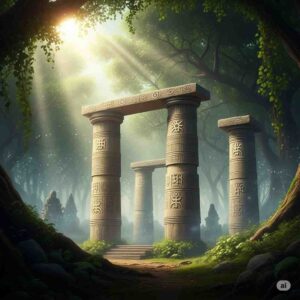
Emperor Ashoka the Great, a figure of immense historical and spiritual significance, left an indelible mark on the Indian subcontinent through his reign from approximately 268 to 232 BCE. After the horrific Kalinga War, his profound conversion to Buddhism led him to propagate the principles of Dhamma (righteousness) across his vast Mauryan Empire. One of the most enduring and visually striking testaments to his legacy are the Ashoka Pillars – monolithic columns of polished sandstone, inscribed with his edicts and topped with magnificent animal capitals. While the legend of “the nine unknown men” remains a captivating myth associated with Ashoka’s desire to safeguard dangerous knowledge, the physical presence of his pillars across the Indian subcontinent is a tangible reminder of his historical reign and philosophical shift.
Today, these majestic pillars are found in various locations across India and parts of present-day Nepal and Pakistan, serving as vital archaeological monuments, symbols of national pride, and pilgrimage sites for Buddhists and history enthusiasts alike. Many have been moved or suffered damage over centuries, but their significance remains undiminished.
Prominent Ashoka Pillar Locations: | The Nine Unknown Men
Here’s a look at some of the most prominent Ashoka Pillars and where they stand today:
- Sarnath, Uttar Pradesh, India: Perhaps the most famous of all Ashoka Pillars, the Lion Capital of Ashoka from Sarnath is India’s national emblem. Though the pillar itself is broken, its iconic capital, featuring four addorsed lions standing on an abacus with a Dharma Chakra (wheel of law) and animal figures, is preserved in the Sarnath Museum. This site holds immense spiritual significance.
- Delhi, India: The Indian capital is home to two Ashoka Pillars, though neither is in its original location.
- Delhi-Topra Pillar: Originally from Topra Kalan in Haryana, this pillar was transported to Delhi by Sultan Firuz Shah Tughlaq in the 14th century and now stands in the Feroz Shah Kotla fort complex. It bears all seven of Ashoka’s major pillar edicts.
- Delhi-Meerut Pillar: Also moved to Delhi by Firuz Shah Tughlaq from Meerut in Uttar Pradesh, this pillar is located on the Delhi Ridge, near the Bara Hindu Rao Hospital. It also contains several edicts but lacks its original capital.
- Allahabad (Prayagraj), Uttar Pradesh, India: This pillar was originally located at Kaushambi and was moved to Allahabad Fort by Mughal Emperor Jahangir. It contains Ashoka’s edicts in Brahmi script, along with later inscriptions by Samudragupta and Jahangir himself. It is currently housed within the Allahabad Fort, which is under military control, requiring special permission to visit.
- Sanchi, Madhya Pradesh, India: While the pillar at Sanchi is mostly fragmented, a similar four-lion capital to that of Sarnath was found here. This capital, though damaged, is now preserved in the Sanchi Archaeological Museum, adjacent to the famous Sanchi Stupa complex, another significant Buddhist monument.
- The lion faces north, the direction Buddha is believed to have taken on his last journey.
- It bears six Ashokan edicts and still retains the Mauryan polish, demonstrating the exquisite craftsmanship of the era. The surrounding area also holds several ancient mounds yet to be fully excavated.
- One is topped with a lion capital and inscribed with edicts, while the other features a magnificent bull capital and is without inscriptions. The Rampurva bull capital is now famously displayed at the Rashtrapati Bhavan (President’s House) in New Delhi, highlighting its artistic and historical significance.
- Lauriya Araraj, Bihar, India: This pillar, located in East Champaran, is an inscribed monolithic sandstone column, but it is currently devoid of its original capital.
- Lumbini, Nepal: Located at the birthplace of Siddhartha Gautama (Buddha), the Lumbini Pillar commemorates Ashoka’s pilgrimage to this sacred site. It is a vital pilgrimage point for Buddhists worldwide and provides definitive proof of Buddha’s birthplace.
- Kandahar, Afghanistan: While not a typical monolithic pillar, rock edicts in Kandahar bear Ashoka’s inscriptions in both Greek and Aramaic, demonstrating the multicultural reach of his empire and his efforts to disseminate his message across different linguistic groups.
The Pillars and the Enigma of ” The Nine Unknown Men “:
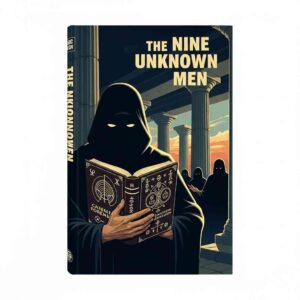
While the Ashoka Pillars are concrete historical artifacts, they exist in a broader cultural context that also encompasses legends like “the nine unknown men.” This captivating myth posits that Emperor Ashoka, after witnessing the immense suffering of the Kalinga War, established a secret society of nine brilliant individuals. Each was tasked with guarding a “book” of highly advanced and potentially dangerous knowledge – ranging from psychological warfare and microbiology to anti-gravity and the secrets of the universe – to prevent its misuse for destructive purposes.
There is no direct archaeological or historical evidence from Ashoka’s time that corroborates the existence of “the nine unknown men.” The legend gained prominence in the 20th century, particularly through Talbot Mundy’s 1923 novel “The Nine Unknown.” However, the enduring appeal of this myth, often associated with Ashoka, speaks to the profound shift in his philosophy. His edicts on the pillars reflect a deep concern for the welfare of all beings and a desire to promote ethical conduct and peace.
The concept of “the nine unknown men” can be seen as a symbolic representation of Ashoka’s commitment to safeguarding knowledge and using power responsibly. While the pillars openly broadcast his Dhamma, the legend suggests a deeper, hidden effort to protect humanity from its own destructive potential. It’s a fascinating juxtaposition: the visible, publicly proclaimed wisdom of the pillars versus the whispered, secret knowledge of a hidden brotherhood.
The Final Journey of the Great Emperor: Where Did Ashoka Die? | The Nine Unknown Men
His transformation from a ruthless conqueror, “Chandashoka” (Ashoka the Fierce), to a benevolent and devout Buddhist monarch, “Dharmashoka” (Ashoka the Pious), following the horrific Kalinga War, is a narrative that continues to inspire. His vast empire, his rock and pillar edicts promoting Dhamma, and his efforts to spread Buddhism across Asia are well-documented. Yet, amidst the grandeur of his life and reign, a precise answer to the question of where Ashoka died remains elusive, shrouded in the mists of time and intertwined, for some, with the intriguing legend of “the nine unknown men.”
The Historical Record: Pataliputra and Beyond
Historical sources, primarily Buddhist chronicles and some later literary works, offer some clues regarding Ashoka’s last days. It is generally accepted that Ashoka died in 232 BCE, after a reign of approximately 36-37 years.
The most commonly cited location for his death is Pataliputra, the magnificent capital of the Mauryan Empire (modern-day Patna in Bihar, India). Pataliputra was the heart of his administration, the center of his Buddhist activities, and likely where he spent his final years. Some ancient texts suggest he died there at the age of 72.
However, historical records from that ancient period are not always as precise as modern historians would wish. While Pataliputra is the most probable location, the exact circumstances and the precise spot of his demise are not detailed in contemporary inscriptions or reliable historical accounts. This lack of definitive information has, over centuries, allowed for other theories and legends to emerge.
The Sannati Speculation: An Archaeological Whisper
In recent decades, archaeological discoveries have added another layer to the discussion. This remarkable discovery, along with numerous Buddhist structures and stupas, has led some scholars and local traditions to speculate that Ashoka might have spent his final days or even passed away in Sannati.
While the presence of such a unique depiction of Ashoka at Sannati is undeniably significant, it does not conclusively prove that he died there. It suggests a strong connection to the region and perhaps a personal visit, but the claim remains largely speculative, driven by archaeological inferences rather than explicit historical records of his death. The idea that his tomb might be “somewhere among the mounds at Sannati” further highlights the lack of concrete evidence for his final resting place.
Unlike many other ancient rulers, Ashoka’s specific burial site or tomb has never been definitively identified. This absence of a clear physical memorial contributes to the mystery surrounding his death. Some traditions suggest that his ashes were immersed in the sacred Ganges River, possibly near Varanasi. This aligns with Hindu and Buddhist practices of cremation and scattering ashes in holy waters, symbolizing a return to the cosmic flow. However, this too remains a traditional belief rather than a historically verifiable fact.
Now, let’s turn our attention to the intriguing phrase “the nine unknown men.” While the legend of this secret society is profoundly linked to Emperor Ashoka, it is crucial to understand that it does not provide any historical insight into where Ashoka died. The legend, which gained significant popularity through Talbot Mundy’s 1923 novel and later esoteric literature, posits that Ashoka, after the horrors of the Kalinga War, established a secret society of nine brilliant minds. Their purpose was to collect, preserve, and advance all branches of knowledge that, if misused, could lead to further destruction of humanity. Each of these “unknown men” was supposedly entrusted with one of nine books containing highly advanced scientific, technological, and philosophical wisdom, kept secret from the masses.
The legend of “the nine unknown men” is a captivating narrative about the ethical responsibility of knowledge and power. It speaks to a profound philosophical shift in Ashoka’s character, transforming him from a conqueror to a guardian of humanity’s future. However, this legendary society operates on a plane of myth and speculative fiction, entirely separate from the historical facts surrounding Ashoka’s death.
- No Link to Ashoka’s Demise: The narrative of “the nine unknown men” does not offer details about Ashoka’s final illness, his last moments, or his exact location of death. Their existence, if believed, would be a secret passed down through generations, their activities clandestine, and their knowledge hidden. It is a story about the legacy of Ashoka’s philosophical transformation, rather than a factual account of his demise.
- A Symbol, Not a Witness: The legend symbolizes Ashoka’s newfound wisdom and his desire to prevent future catastrophes by safeguarding dangerous knowledge. The “secrets of the 9” are about advanced wisdom (like gravitation, psychology, microbiology, etc.), not about the mundane details of a monarch’s death.
- The Power of Myth vs. Historical Fact: While the legend is compelling and has inspired numerous works of fiction and speculation, it is essential to differentiate between historical fact and captivating myth. The existence of “the nine unknown men” itself is unproven, let alone their bearing witness to, or influencing, Ashoka’s death.

